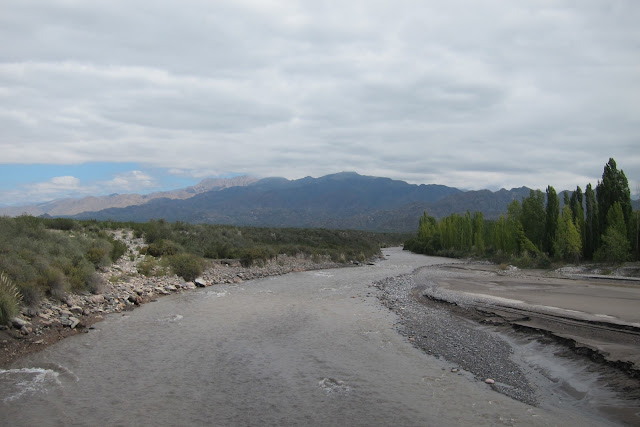The TIES-Argentina Biology unit started off with a morning lecture from Dr. Todd Wellnitz followed by an afternoon activity at the Mendoza Zoo. The zoo was more old-fashioned than we were used to, allowing us to get closer to the animals than zoos back home. A troupe of monkeys wandered the grounds begging for food and entertaining patrons, something we were surprised to see. We observed the different adaptive features of monkeys, bears, birds, elephants, and other animals. The zoo sprawls across Cerro de la Gloria in Parque San Martin, with a wonderful array of beautiful flora, and we really enjoyed the afternoon with our peers. This was also an excellent exercise in people-watching, as many families were also strolling the zoo’s grounds on Sunday afternoon.
 |
| TIES crew and assessment team assembled for the start of the Biology section |
For our first Biology trip we revisited Uspallata for five days. Once we arrived and settled into the hostel, we ventured down the road to do a preliminary survey of plant life in the high desertTher and to choose a topic for our practice project. Groups then developed a hypothesis based on their observations and worked to develop a methodology for testing this hypothesis for the following day. The TIES team then recharged with a talk from Jane Pederson (of UWEC’s History department) on handling horses, an asado (we can’t get enough!), a clear view of the stars, and some friendly ping-pong matches.
Day two started in the field at a very student-friendly (and appreciated!) 10 A.M. We began collecting data according to our protocols, altering them as our individual studies required. After fieldwork, students were split into two groups for a one-hour horseback “training” ride - a chance to practice handling the horses (as a few students had never ridden before) and take in some of the stunning scenery nearby. This also offered us the opportunity to meet our guides for the trip, three brothers and their cousin who are gauchos (or Argentine horsemen). Many of us found the ride both relaxing and invigorating and we traded much of our anxiety about the upcoming trek for excitement.
 |
| Westward ho! Headed into the Frontal Cordillera on horseback |
On day three, TIES saddled-up to take on the Andes and our second biology projects with our groups. We rode for about four hours before taking a lunch-and-biology break. Teams each investigated a topic (human impact on the ecosystem, ants, a conveniently-located cow carcass, and stream-critters) in the immediate area and gave a brief presentation about their findings. After two more hours of riding, we arrived at our camp. Nestled in a valley alongside a stream, tents went up, the stars came out, and we enjoyed another asado prepared by our gaucho friends and guides.
 |
| Horse camp at Chacai Creek (6400') in the Frontal Cordillera |
 | |
|
 |
| Team Arthopod with Todd Wellnitz collecting diversity data on transects |
 |
| Team Cacti collecting data on barrel cactus |
After a quick lunch at camp, horses and mules were loaded and the caravan, exhausted in all the best ways, rode four hours back to the hostel to board the bus back to Mendoza. Overall, the trip was outstanding, and the TIES crew extends its utmost appreciation to the guides and gauchos of Mendoza Mountain for their knowledge, professionalism and good cheer!
 |
| TIES crew with gauchos and guides at base camp |


























